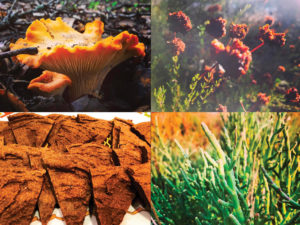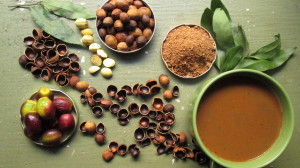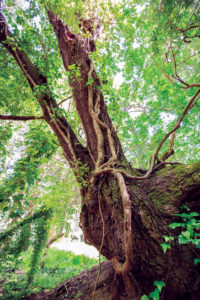Walk down almost any trail in the Bay Area’s woodland hills and canyons and you’re likely to encounter a California bay laurel tree arching sinuous limbs over your head, dappling light across your face, and sending a sharp sweet-bitter smell reminiscent of menthol and camphor straight up your nose.
The California native Umbellularia californica—also called pepperwood, Oregon myrtle, California sassafras, and headache tree—is in the same family as the true or Grecian laurel (Laurus nobilis) whose dried, oblong leaves are growing stale in most home spice racks. California bay can also be used to season stews and soups, but be careful—our bay leaf is much more potent than its Mediterranean cousin.
A hardwood that can live for hundreds of years, the bay laurel tree is emblematic of the Bay Area for some. It grows only in the “California Floristic Province” in California and southwestern Oregon, and yet it is widespread and highly adaptable within that range. The trees grow in the foothills and coastal riparian areas, fog-shrouded redwood forests, rain-drenched southern Oregon, and the dry southern Sierra Nevada. They’re even adaptable enough to endure the inland heat of chaparral country in scrub form if they find the moisture and shade essential to their survival. They’ve been used for ecological rehabilitation projects, including habitat rebuilding, flood control, and riparian-zone restoration.
Our bay tree is food for native animals such as black-tailed deer that graze the high-protein, early-season leaves and twigs. Steller’s jays forage the fruit, as do western gray squirrels, dusky-footed wood rats, and California mice. Wild pigs eat both the fruits and the roots. The tree’s dense canopy provides valuable cover and habitat for many woodland species.
Humans love the tree too. While the aroma from the leaves may be what first dazzles, it’s the fruit (known as bay nuts) that send local food foragers scrambling through the woods in the fall. And not just because they’re jonesing for the seed of the fruit’s reputed stimulant effect. When dried and roasted properly, the nickel-size seeds also taste like roasted coffee. Or dark chocolate. Or burnt popcorn. Or all three, depending on whom you ask.
And they are versatile. The waxy fat of the seeds gives them a consistency like cacao, so when pulverized, they’re easily molded into sweets, brewed into beverages, or blended into spicy mole sauces. They can also be nibbled alone as crunchy snacks. But don’t gobble a handful at once. As with the leaves, the flavor is intense.
Bay nuts have long been eaten by native tribal peoples in California and Oregon—Cahuilla, Chumash, Pomo, Miwok, Yuki, Coos, and Salinan, to name a few. When powdered, the oily seeds were pressed into small cakes, then dried and stored to eat through the winter. A strong tea made from the leaves was considered a good skin wash for bacterial or fungal infections, as well as a head wash for repelling lice and fleas. Tribes also used the leaves to deter pests from their acorn granaries.
Unfortunately, biologists have discovered that bay laurels are prime vectors for the pathogen Phytophthora ramorum, the villain behind sudden oak death, which has killed more than a million oak and tanoak trees across California in the last decade or so. The bay tree goes unharmed but provides an ideal host environment for the spores of P. ramorum to spread to neighboring oaks, which may succumb to the disease.
Five years ago, the Midpeninsula Regional Open Space District started cutting down selected bay trees—mostly smaller ones growing near large oaks—in the Santa Cruz Mountains. If done early enough, this appears to have an impact, according to district biologist Cindy Roessler. The research is relatively new, “but compared to nearby control trees, we have seen better survival of coast live oaks, canyon live oaks, Shreve oaks and tanoaks,” Roessler says.
Despite its hardiness, the bay is threatened by longer-term shifts in its habitat. A 2008 paper by UC Berkeley scientist David Ackerly suggested that like much of California’s endemic flora, bay laurels could lose some of their habitat due to warming temperatures and altered rainfall patterns caused by climate change.
But for now, bay laurels are still abundant in many of our wooded areas. So if you haven’t tried roasted bay nuts yet—or our native bay leaves—well, don’t rest on your laurels.





